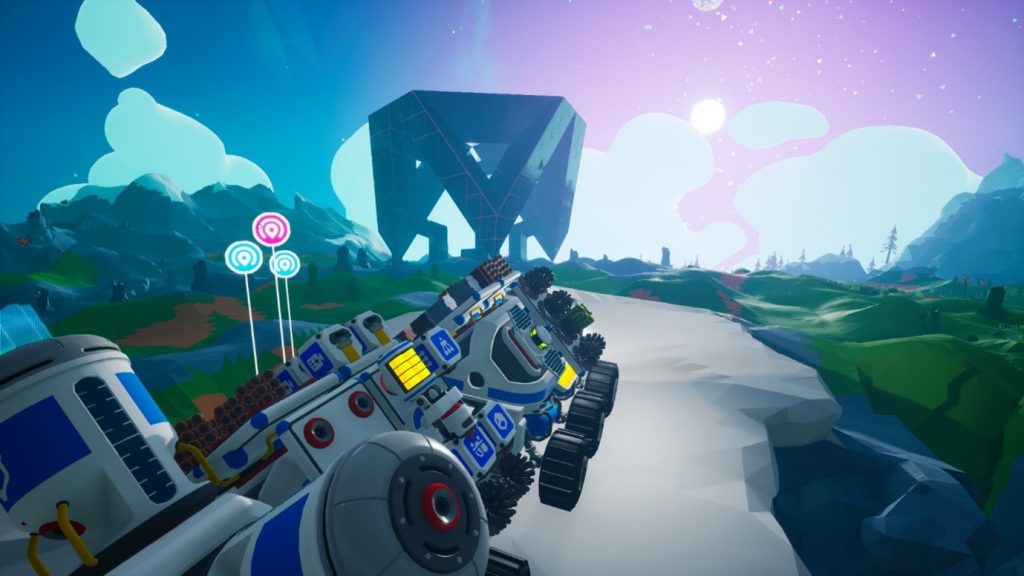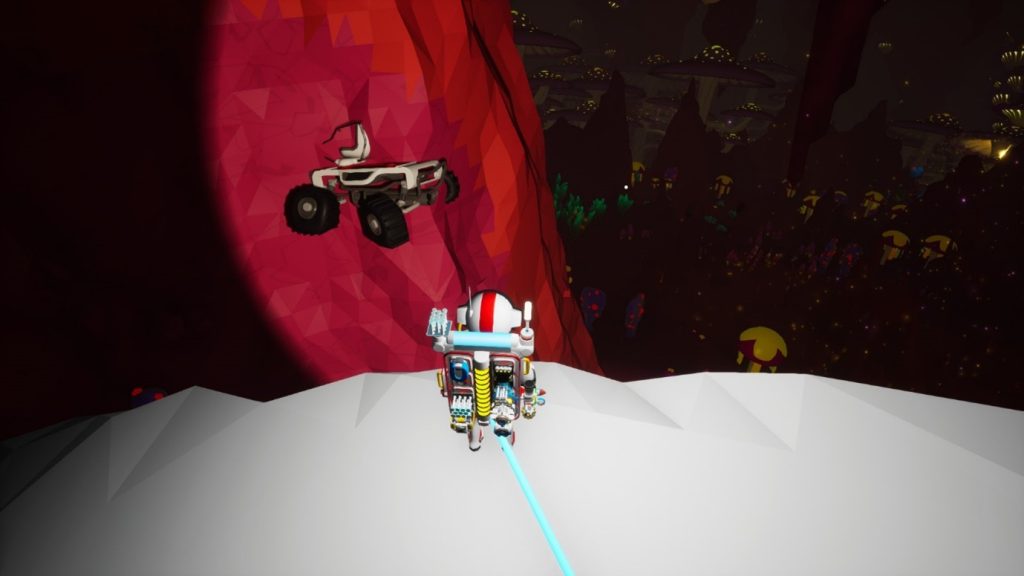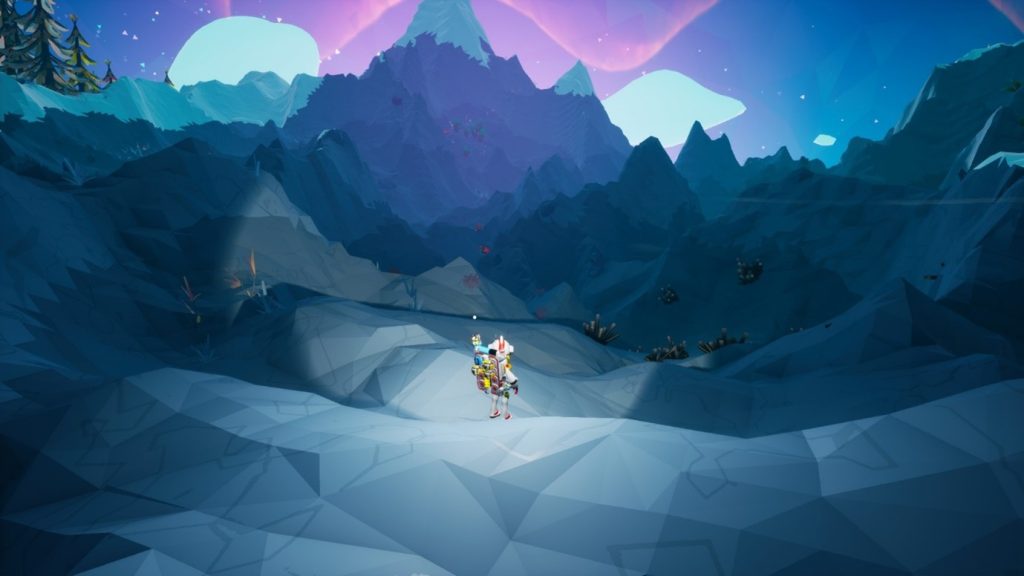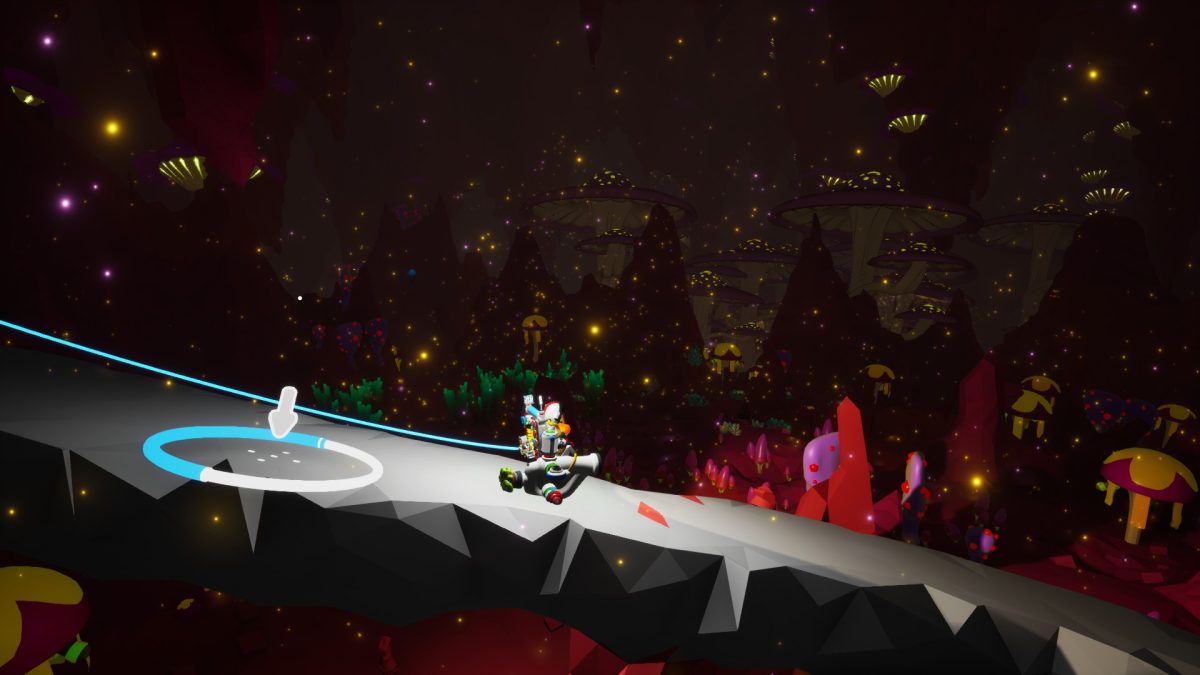Astroneer, seemingly a portmanteau of ‘Astronaut’ and ‘Pioneer’, is a sandbox low-poly space exploration game in which players take on the role of a spacesuit-wearing individual or robot whose identity remains obscured.1 While future-focused, it is also a historical game based on memory. Players explore uninhabited, procedurally-generated worlds that mostly appear natural, but feature ruins of an ancient civilisation (and ‘ghosts’ of past playthroughs), evoking historical-cultural contexts of space exploration and colonisation.
Astroneer’s incentivising of exploration and transforming of alien worlds through resource extraction, as well as its enabling of player agency, have already been studied.2 However, there is only limited research on Astroneer, and none in relation to memory itself, particularly in understanding the interactions of multiple layers of memory and significance of online “Let’s Play” and livestream videos in processes of historical memory. Such videos have added a level of recording and collective memory-formation to Astroneer, through critical self-awareness and the invocation of memory subjects by players as they consciously reflect on their ludic environment.
This post will briefly analyse Astroneer’s interweaving of memory on multiple levels, including those of environment, player, and (when shared) community. The choice is inspired by applied research of the game and its online media, and by adaptations of Paul Ricoeur’s tripartite model of mimesis, mapping these levels onto pre-figuration, configuration, and re-figuration of narratives, while offering new insights into the potential for paradoxical memory and historical interactions in a ludic context.3 These three layers involve studying how the existing environment in Astroneer is representatively constructed through memory (pre-figuration, although in ludic rather than textual form), how the player composes and shapes those representations into a narrative through their own memory interactions (configuration), and finally how this constructively remembered reality is received and understood by a community (re-figuration).
Environmental Memory
Astroneer’s distinct features include a solar system of procedurally generated planets which are almost entirely destructible. Players explore unique environments in which they can (if they choose) drill to a planet’s centre. Games can intuitively shift between single player or multiplayer, enabling sharing of previously individual gameplay experiences. Environments are brightly coloured, with few hazards or requirements beyond easily replenishable oxygen. Players instantly respawn at their base if they die, the only losses being of materials or equipment carried, which are preserved at the location where they died. Although Astroneer developer updates have increasingly introduced narrative elements as ‘quests’, these remain optional, game experiences not having a fixed narrative or goal beyond those created by player actions and interactions with game worlds.
Assets in Astroneer are procedurally-generated: no two planets or combinations of features are the same. When a player carves through a terrain feature it is irreplaceably lost, short of reverting everything to a previous save file. In this respect, there is a significant persistence of memory for every object created, moved, or destroyed. The enduring state of this environment resonates with discussions around Archaeogaming and studying material culture within games, including the material qualities of the Astroneer gameworld itself as forming part of a historical record.4
Paradoxically, Astroneer nonetheless represents the ultimate Terra Nullius, the persistent memory of how players exploit the land not creating meaningful consequences (except when players accidentally fall into self-dug holes). Apart from oxygen-depletion, the only hazards involve fall damage, or attack by hostile flora, with any loss of resources seemingly only a temporary setback. Life primarily consists of plants which, as attested by players in online videos, are ‘othered’ by design as ‘alien’ or weed-like, represented merely as a hazard or opportunity for more resources. While features and positioning on each planet are unique, objects are drawn from a preset library. There are, for instance, colour-patterned spherical items, appearing as plants or minerals, harvestable by the player to gather research ‘bytes’ and unlock more advanced technology. These items are destroyed when processed for research yet they lack any uniqueness to incentivise preservation, leaving no memory other than the quantity of anonymous ‘bytes’ contributing to scientific advancement.
The only indestructible objects beyond the player’s starting base would appear to be purple monuments left behind by an ancient civilisation on Astroneer’s planets and moons. There are also pieces of technology, from scrap metal to solar panels or vehicles, of similar aesthetics to the player’s, ruined or functioning, scattered across different worlds and seemingly left by previous unnamed players. While this technology can be recycled or destroyed, this is far more difficult than mining the natural resources. These technological developments, through game mechanics, are thereby seemingly reified as providing more permanent memorials than the natural world around them, and for the player, memorials that are potentially more meaningful.

Player Memory
Although Astroneer preserves the results of all player interactions with the terrain, in contrast to many exploration games it does not provide a detailed mini-map or an in-game system for notetaking. Players have a compass and can place unlabelled colour-coded beacons, but not see these beyond a certain distance. Glowing tethers, essential for life-giving oxygen, can provide a trail to follow, but, as seen in different videos, the proliferation of these can rapidly result in players ‘forgetting’ where the ‘roads’ lead, especially if time passes between accessing a save-game.
As such, player navigation very much depends on their own memory of game actions, heightening the importance of their observing the unique procedural environment to avoid becoming lost. The correlation between death and loss of memory is illustrated explicitly in a popular Let’s Play video, in which players comment on those who have lost their memory being unable to navigate the world, exploring and making such fatal mistakes as losing their oxygen tether line.5 In some cases, players have used the terrain itself to create memorable landmarks in what, to them, appears an otherwise indistinct landscape.

A further paradox is the way in which the push towards heightened player memory sometimes subtly nudges players to confront consequences of actions in Astroneer. Different widely viewed Let’s Play videos include reflections on the uncomfortable presence of unintended ‘memorials’ in the landscape: the backpacks or machine debris of unnamed, deceased ‘Astroneers’. In these videos, players sometimes actively wonder if they have accidentally stumbled into a larger multiplayer world, or show visible discomfort at the technological detritus suggesting evidence of former players.6 This discomfort can also extend to when player characters themselves die. In a strange version of a memorial journey, whether single or multiplayer, the revived ‘Astroneer’ will often go to the location of their now disappeared ‘corpse’, to retrieve resources and equipment from their backpack, having to relive their actions which led to that ‘death’. In some regards, this journey may be evocative of earlier, and sometimes controversial, ‘corpse runs’ in MMORPGs, of players needing to face in-game discomfort when respawning after virtual death. Astroneer’s version involves no loss of in-game experience points and all items are theoretically recoverable, making the loss more marginal in time spent, but retaining psychological discomfort for some players through the way the memory of their demise is invoked.
Community Memory
Astroneer’s community interactions produce further paradoxes in forming memory. As with many video games, some livestreams or “Let’s Play” videos, beyond expected mining and exploitation of resources, have sought to ‘exploit’ or push the boundaries of game mechanics to their limits for entertainment or challenge. In several cases, such actions involve large-scale destruction of ludic ‘memory’, in the form of detonating sizeable parts of a planet or moon with explosives. Paradoxically, and poignantly, this destruction has been shown physically to be limited by the capacity of computer RAM to represent this onscreen. The end result, in at least three “Let’s Play” videos involving such experiments, was to reduce the speed of the game so far as to make it effectively unplayable, in some cases even crashing the game.7 As such, players were able to partially achieve their goal, but at the cost of their ludic experience and further appreciation (or destruction) of the uniquely-generated worlds in that file. ‘Memory’ itself underpinning Astroneer’s game architecture thereby became a limitation on the act of creative destruction.
However, capturing these ludically destructive acts in video form and sharing them online also transforms otherwise individual experiences into collective memory sources for comment and future viewing. There appears no mourning for lost digital ludic potential in the destroyed worlds, celebrated as triumphs rather than tragedies. This re-figuration, like Ricoeur’s cyclical interpretations of culture which create texts that shape new interpretations, inspires further such experiments in Astroneer.

Equally, creativity, and the importance of memory in different forms, has served as an incentive for players to go through added discomfort to ‘not’ break their game. In one popular “Let’s Play” series, two players tunnelling through the centre of the planet Sylva with a complex vehicle they had built, returned to the surface completely lost, with no indication as to the location of their home base.8 What began as a mistake was narratively transformed into a livestream quest to find ‘home’ base, lasting over an hour and supported both by those in the audience chat and another team member in orbit and on the planet. These two players eschewed the easy solution of destroying themselves and respawning at their base. In part, such an approach could have seemed less than heroic for the livestream audience. However, it may equally be explained by a desire to retain ‘memory’. There had been references made during the journey to the planet core to the vehicle they had taken a long time to build. In this respect, the subsequent journey home itself and the vehicle took on greater significance to them: these were not only collections of resources and creative labours, but also important in preserving the memories these players had created of exploration and discovery with the community, which they potentially expressed a reluctance to lose. Astroneer’s terrain, exploited for its resources and collective entertainment value, nonetheless becomes more than a backdrop for exploration. It transforms into a canvas where memories are formed, shared, and revisited. The multifaceted nature of this memory engagement within a virtual solar system, and livestreamed cosmos, whether in the environment, players or community, is itself a further prompt to study the significance of human memory and shared histories of space and video gaming experiences.
Timothy Peacock is Lecturer in History and War Studies, and Co-director/co-founder of Games and Gaming Lab (UofGGamesLab/GGLab) at the University of Glasgow. His research interests span early modern and modern, socio-political and military, with a particular focus on Spaceflight History/Science Fiction, Nuclear, Games and Wargaming, AI, and Politics. He leads cross-disciplinary projects on research-informed gaming, from co-creating tabletop crisis simulations of flooding Glasgow (Project Tempest) to finding new ways of using AI to transform cultural heritage sites into historical video games (Project HeritAIge).
Notes
- Information on features from https://astroneer.wiki.gg/wiki/Astroneer_Wiki and applied research of the game. ↩︎
- B. Bódi (2021) ‘Can Playfulness Be Designed? Understanding Playful Design through Agency in Astroneer’, Eludamos: Journal for Computer Game Culture, 12(1), pp. 39–61. ↩︎
- S. Caselli (2021), ‘Playing Sites of Memory: Framing the Representation of Cultural Memory in Digital Games’, Journal of Digital Media & Interaction, 4(11), pp. 42-59. ↩︎
- A. Reinhard, Archaeogaming: An Introduction to Archaeology in and of Video Games (Oxford: Berghahn Books), pp. 8-9, 166-7. ↩︎
- https://www.youtube.com/watch?v=-86NTG1Cxiw ↩︎
- Ibid. ↩︎
- https://www.youtube.com/watch?v=MjiZrDrGCcc; https://www.youtube.com/watch?v=HkDfIclJoHA; https://www.youtube.com/watch?v=jpuh2hbvfXg ↩︎
- https://roosterteeth.com/watch/achievement-hunter-stream-archive-2020-astroneer-7-15 ↩︎
